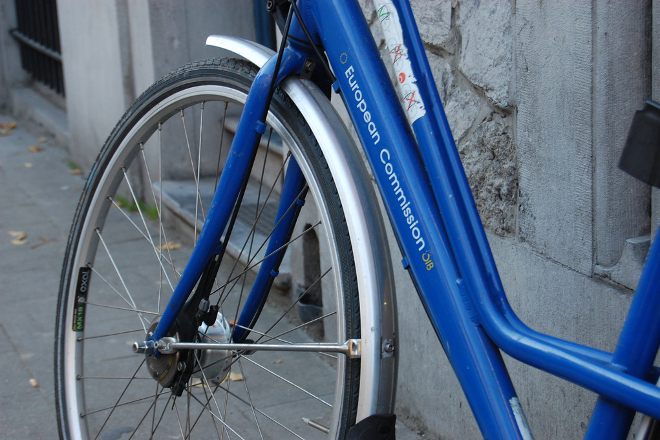
ECF Roundup: The EU's new Urban Mobility Package
Backed by a new survey that finds 12% of Europeans cycle daily, the EU Commission has recently published its brand new Urban Mobility Package. Here is our overview about what it will mean for cycling in the EU.
About 250 million EU citizens, half of the population, are cycling. That’s one of the key results of the Eurobarometer on urban mobility that was published by the European Commission in December 2013. 12 % of the respondents replied that they cycle “at least once a day” – this makes 61 million daily cyclists in the EU. 17 % replied “a few times a week” (=86 million); 20 % said “a few times a month or less often” (=101 million).
The Eurobarometer was published alongside the Urban Mobility Package of the European Commission, which builds upon the first Urban Mobility Action Plan published in 2009 and sets out the guidelines for EU policies in the field for the coming years. For ECF, the question is clear: What does the package contribute to ECF's main objective - getting more people to cycle more often?
A package that's good for cycling
12 percent? A word on travel data
Does 12% percent "daily cyclists" mean 12% cycling in the modal split? Not so fast, says Fabian Küster, as different Eurobarometer statistics sometimes use different questions and methods.
"As much as ECF welcomes this new evidence for strong practice of cycling in Europe, it cannot be a substitute for consistent and harmonized collection of data and statistics of all transport modes, including cycling, in all EU Member States. All transport policies start and end with good data in order to set meaningful modal split objectives and measure the impact of implemented policies. Current collection of data and statistics in Europe is just not up to this job," he says.
The last Eurobarometer asking for the modal share of cycling (in 2010) said 7,4% of Europeans cycle as their main mode of transport.
See more on our facts & figures page.
"ECF mostly agrees with the Commission on the challenges it identifies for urban mobility," says ECF Senior Policy Officer Fabian Küster. Indeed, the Commission says the CO2 emissions from urban transport are still too high, that too many cities do not yet comply with EU air quality regulations, and that congestion and road safety are still widespread problems in Europe.
Fabian Küster explains, "In this context, ECF welcomes that the Urban Mobility Package acknowledges the health benefits of walking and cycling, and that it calls for a modal shift towards active mobility." The Commission also says it wants to promote “new approaches to urban mobility planning […] as local authorities seek to break out of past silo approaches.”
Recommendations to member states for the first time
A novelty in urban transport is that the Commission gives specific recommendations to Member States. In addition, the Commission proposes to the Member States to set up a “Member States Expert Group on Urban Mobility.” This group is supposed to foster an “exchange of how national and EU policies on urban mobility and transport can be strengthened and better coordinated”.
For its recommendations, the Commission has identified 5 working fields:
- Sustainable Urban Mobility Plans (SUMPs)
- City logistics
- Access regulations
- Road user charging,
- Intelligent Transport Systems (ITS) and road safety
Below is our overview about what the different fields would mean for cycling. Each working field has its own working document. Click on the accordion headers to see the links along with our analysis.
Sustainable Urban Mobility Plans (SUMPS)
In the Annex document “A Concept for Sustainable Urban Mobility Plans” (SUMPs), the Commission publishes recommendations on how local authorities should develop, implement and evaluate such plans. Also on the to-do list for 2014: the Commission will set up a “European Platform on Sustainable Urban Mobility Plans” and pledges to “support national, regional and local authorities to develop and implement Sustainable Urban Mobility Plans, including through funding instruments”.
Although there is still little hard empiric evidence that SUMPs actually do increase levels of urban cycling, the Commission maintains that “A Sustainable Urban Mobility Plan fosters a balanced development of all relevant transport modes, while encouraging a shift towards more sustainable modes.” As a concrete example, the Commission recommends that SUMPs shall ‘explore’ “the potential for reallocating road space to other modes of transport or other public functions and use which are not related to transport”.
Fabian Küster had wished for clearer language from the Commission, however. "Exploring possibilities is not enough. Reallocating road space to walking and cycling is the essence of making cities truly walking and cycling friendly," he says. Fabian Küster points out that the Commission's recommendations are also not binding to member states, either. "We will have to make sure we work together effectively with our members and the EU to remind member states to take sustainable urban mobility seriously."
City Logistics
In its working document "A call to action on urban logistics" the Commission explores possibilities for alternative forms of good transport. It does indeed acknowledge that here as well, not only in passenger transport, there is potential for a modal shift:
“Urban logistics remains dominated by road transport. But analysis of freight patterns can identify certain flows (e.g. light short distance or heavy regular flows) that can be more efficiently moved to alternative modes of transport such as bike, boat or rail.”
What's more, the Commission quotes one of the main results of the Cyclelogistics project, namely that 25% of goods transport could be achieved by bicycle in the EU. As an example, the Commission explains how Outspoke delivery in Cambridge has changed the way goods are delivered in the city after access regulations for cars had been introduced.
Smarter urban access regulations & road user charging
Other than taking into account how urban access regulations can help push goods delivery towards more sustainable options, the Commission also says that access regulations are a good way to promote the modal shift (see the corresponding working document).
From the document: "Cities are particularly suited to the early adoption of alternative types of mobility because their high densities, which make alternative transport services (public transport, car sharing) economically viable, and the short distance of many urban trips make walking and cycling a viable option."
Intelligent Traffic Systems (ITS) and road safety
Road safety should be an essential component of SUMPs as well, the Commission argues in the respective working paper. Whereas ECF agrees that this is true, the specific to-do’s of the Commission are neither new nor very detailed. They include:
- Gather and disseminate good practice examples for road safety planning
- Analyse measures for reducing the numbers of serious road traffic injuries in urban areas.
"The Commission must address the number one road safety problem: speeding," says Fabian Küster. "ECF thinks that 30km/h should become the default speed limit on all built-up urban roads. However, non-compliance with speed limits is very wide-spread." One of ECF's priorities, therefore, will be to push the Commission towards more support for Intelligent Speed Assistance (ISA), which has great potential in reducing the risks to pedestrians and cyclists.
"A promising step is in linking road safety with health and environmental factors. It is essential that the health benefits of cycling are taken into account when dealing with road safety. Cycling is an active form of transport and the positive public health benefits must be taken into account along with the risks," Fabian Küster comments.
European citizens, after all, seem to care a lot about road safety. The Eurobarometer survey revealed that almost three in four citizens consider road safety to be a serious problem in cities. Taking these concerns seriously and finding adequate answers are the key to successful SUMPs.
On Intelligent Transport Systems (ITS), ECF agrees with the view of the Commission that a number of ITS applications have considerable potential in promoting the use of cycling as well as making cycling safer. This applies in particular to interoperable multi-modal journey planners, standardization of data formats and interfaces for bike-sharing schemes, and road user detection (e.g. blind spot warnings).
Download: The proposed actions in detail and further information
 ECF has prepared an overview of the proposed actions in detail. Download it here and see what can be done at the EU level - to help spread the cycling virus even further.
ECF has prepared an overview of the proposed actions in detail. Download it here and see what can be done at the EU level - to help spread the cycling virus even further.
If you are looking for further information, do not hesitate to contact one of our Policy Officers.
For other position papers and ECF documents, head over to our Library.
- Log in to post comments
Contact the author
Recent news!
Upcoming events
Contact Us
Avenue des Arts, 7-8
Postal address: Rue de la Charité, 22
1210 Brussels, Belgium










